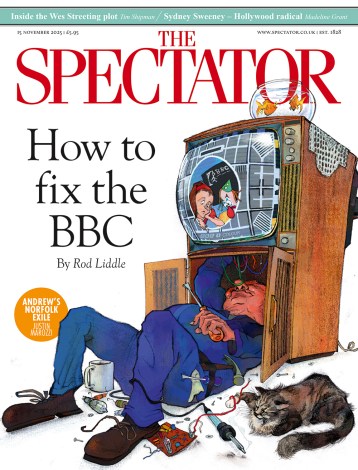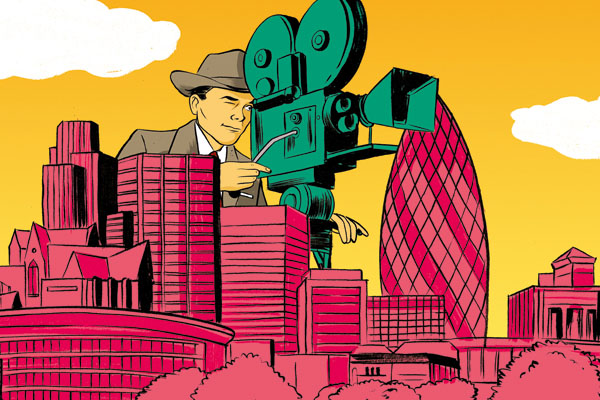What used to be called the National Film Theatre, now BFI Southbank, is a weird sort of place. On the outside it is unprepossessing to the point of ugliness: a concrete mass sitting beneath the southern end of Waterloo Bridge, squat against the Thames, where it sulks away from the sunlight and overhead traffic. Whereas, on the inside, it offers a pretty jumble of conveniences for its clientele: a grand upholstered auditorium; a scattering of more utilitarian screens; a digital library of film called the ‘Mediatheque’; and a glassy bar and shop. The effect is rather like those ‘Ascent of Man’ diagrams that show the evolutionary links between monkeys and us, except in this case it’s for the movie theatre business.
Yet for 11 days in October this peculiar building will be shrouded in Gauloise smoke and air kisses as it becomes the centre of London’s cultural scene. By my count, a quarter of the BFI London Film Festival’s 500-plus screenings will be held here, with the rest spread across 13 other venues in the capital. There will be movies from America, Serbia, Sri Lanka, Egypt and most places in between. The world is coming to London — just as it did for the Olympics.
Putting aside the quality of the films for now, the British Film Institute and its spiritual home on the Southbank deserve a successful festival. It has, on the whole, been a momentous year for the Institute. Its house magazine, Sight & Sound, recently published the results of its once-a-decade poll of critics and filmmakers to identify the best films of all time; Orson Welles’s Citizen Kane (1941) was deposed from the top spot for the first time in 50 years, replaced by Alfred Hitchcock’s Vertigo (1958). But, more importantly, during this time of reduced state funding, the BFI sets about its task with little fuss, and even with some panache. An imaginative campaign to raise cash — in great and small amounts — for the restoration of several early Hitchcock films resulted in one of the best screening seasons that I’ve ever emptied my wallet on.
I’m itching to see ‘John Dies at the End’, the latest film by that maestro of the weird, Don Coscarelli
So what about the films at this 56th BFI London Film Festival? Much of the advance promotion is devoted to the two special ‘galas’ that will bookend the whole thing; both of which will be held at Leicester Square, presumably because there isn’t enough glitz under Waterloo Bridge.
The first is for Tim Burton’s latest film, Frankenweenie, a stop-motion animation about a boy and his deceased (but not for long) dog, which references the old Universal horror films of Karloff and Lugosi, right down to being in black and white. And the second is for Mike Newell’s adaptation of Great Expectations, which is, y’know, Dickens. They’re safe choices on the surface — both are big releases, autumnal in tone, and made with heavy British involvement — but there’s actually some risk attached. Is this brilliant Burton (Batman Returns, The Nightmare Before Christmas) or terrible Burton (Alice in Wonderland, Planet of the Apes)? Will this Great Expectations wilt in comparison to David Lean’s 1946 version?
We shouldn’t dwell on these questions for long, however, as the real action is to be found elsewhere. Michael Haneke’s Amour may have hit the Cannes Film Festival first — as tends to happen — but the Palme d’Or it won hardly counts against seeing it on London screens. And there are other Cannes victors present, too, including Carlos Reygadas’s Post Tenebras Lux, a cut-up contemplation on town and country. Oh, and while it didn’t do anything at Cannes, there’s also John Dies at the End, the latest film by that maestro of the weird, Don Coscarelli, that I’m itching to see. Its summary in the festival programme involves the following: time/space continuum, monsters, soy sauce…
As for British film, there is a happy balance between quantity and quality this year. Top of the list is Sightseers, whose director Ben Wheatley made last year’s wonderfully ambiguous, morbid Kill List. But Sally Potter’s Ginger and Rosa, Michael Winterbottom’s Everyday and Sally El Hosaini’s My Brother the Devil also stand out. And, while it’s technically an American production, one of the festival’s few world premières is definitely Brit-centric: Crossfire Hurricane, a new documentary to mark the 50th anniversary of the Rolling Stones. It will be accompanied by an event entitled ‘50 years of the Rolling Stones on screen’ that, given the quality of Stones films such as Sympathy for the Devil (1968) and Gimme Shelter (1970), should be pretty worthwhile.
And then there’s my favourite component of past festivals: the ‘Treasures’ programme. This is where the new restorations of old films belong, and where the audiences tend to be greyer in the hair department. This year, there’s another in the BFI’s Hitchcock season, The Manxman (1929), that has been given a gala of its own. And there are also screenings for the luminous new restorations of Lawrence of Arabia (1962) and Wings (1929), which has gained some notice this year for being the last silent film to win the Best Picture Oscar before The Artist (2011). But these will get attention enough, whereas Jack Garfein’s Something Wild (1961) — starring two particularly raw actors, Carroll Baker and Ralph Meeker — might not. There will be few more harrowing films shown all festival.
At which point, if you live in Aberdeen, Aberystwyth or Aberford, you might be wondering, ‘What do all these London-based festivities mean for me?’ But, so long as you’re a film fan, the answer is considerably more than nowt. Major film festivals have always been expansive affairs: they are often where distribution and home video deals are struck. But they are also becoming more expansive by the year: with the endless spread of blogs, Twitter and online video, festivals are now live events even for those who cannot attend them. The London Film Festival could have a very real effect on which movies percolate down to regional cinemas and television screens, or to the minds of those cinephiles who, in increasing number, are arranging screenings and mini-festivals of their own.
The writer Annie Winifred Ellerman, who went by the pen name of Bryher, once argued that cinema would survive only through small groups projecting ‘scraps of film’ on to ‘kitchen walls’. She had something angry and very radical in mind, but now we can see her words in a different context. From the BFI Southbank to a kitchen wall near you — that is, perhaps, the main joy of this London Film Festival.






Comments